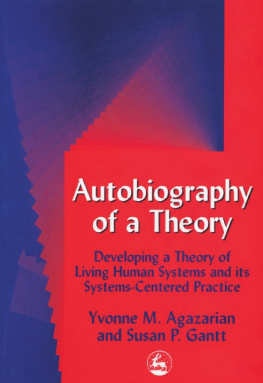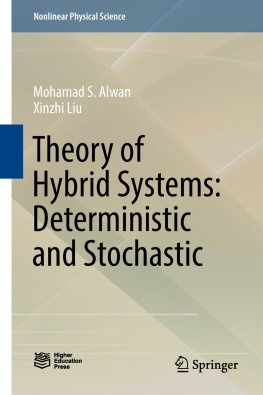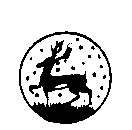Autobiography of a Theor y Developing the Theory of Living Huma n Systems and its Systems-Centered Practic e
Yvonne M. Agazarian and Susan P. Gantt
Jessica Kingsley Publisher s London and New Yor k
All rights reserved. No part of this publication may be reproduced in any material for m (including photocopying or storing it in any medium by electronic means and whether o r not transiently or incidentally to some other use of this publication) without the writte n permission of the copyright owner except in accordance with the provisions of th e Copyright, Designs and Patents Act 1988 or under the terms of a licence issued by th e Copyright Licensing Agency Ltd, 90 Tottenham Court Road, London, England W1 P 9HE. Applications for the copyright owners written permission to reproduce any part o f this publication should be addressed to the publisher . Warning: The doing of an unauthorised act in relation to a copyright work may result i n both a civil claim for damages and criminal prosecution .
The right of Yvonne M. Agazarian and Susan P. Gantt to be identified as authors of thi s work has been asserted by them in accordance with the Copyright, Designs and Patent s Act 1988 .
First published in the United Kingdom in 2000 b y
Jessica Kingsley Publishers Lt d
116 Pentonville Roa d
London N1 9JB, Englan d
an d
400 Market Street, Suite 40
Philadelphia, PA 19106, US A
www.jkp.com
Copyright 2000 Yvonne M. Agazarian and Susan P. Gantt
Library of Congress Cataloging in Publication Data
Agazarian, Yvonne.
Autobiography of a theory : developing systems-centered theory / Yvonne M.
Agazarian and Susan P. Gantt.
p. cm. --(International library of group analysis ; 11) Includes index. ISBN 1 85302 847 9 (pbk. : alk paper)
Group psychotherapy--Philosophy. 2. Group psychoanalysis--Philosophy. 3. social systems. I. Gantt, Susan Porter, 1951-II. Title. III. Series.
RC488. A6224 2000 616.8915201-dc21 99--056717
British Library Cataloguing in Publication Data
Agazarian, Yvonn e Autobiography of a theory : developing systems-centered theor y
Agazarian, Yvonne 2. Social psychology -Philosophy
Group psychotherapy 4. Group psychoanalysis
I. Title II. Gantt, Susan P.
616.8915 ISBN 1 85302 847
Printed and Bound in Great Britain b y Athenaeum Press, Gateshead, Tyne and Wea r
Content s
acknowledgements 6
Introduction: Curiosity and Early Musings 1 Trying to Make it Make Sense: Chang e as a Function of Discrimination and Integration 2 2 The First Try at Theory 4 3 Second Theory: Theory of the Invisible Group Bridg e Construct of Role between the Individual and the Group 7 4 Theory of the Group-As-A-Whole 10 5 Thinking Systems 14 6 Systems-Centered Practice 17 7 A Theory of Living Human System s and its Systems-Centered Practice 22
references 255 subject index 263 name index 269
Acknowledgements
For my son Jack for his appreciation of theory .
For my mentors David Jenkins, Jay Fidler, Len Horwitz; for th e members of the theory seminars who have lived through many version s of the theory chart; for Ken Eisold for understanding; for my friend s Anita, Claudia and Fran; and particularly for Berj .
From me, Susan, enormous gratitude for all the support I received , most especially from Kirk . Much thanks to my mother in her generosity, especially in using Lak e Burton as our writing site; and for the support from my family (Betsy , Marty, Joel, Jessica, Julian), and from Jan, Vicki, Carol, Robin; and fo r all the training and mentoring from Fran. Thank you all .
Two more important dedications to all our systems-centere d colleagues, and to Jessica Kingsley and Helen Parry with our gratitud e and affection for their warmth, the quite wonderful experience o f working with them, and for their support that helped us bring thi s book into reality .
Introductio n Curiosity and Early Musing s
Curiosity Killed the Cat Information Brought it Back!
When Nanny answered my whys with because the sky is so high, Id ask, How high is the sky? When she cautioned me that Curiosity killed the cat, I would say, Information brought it back, and sometimes, when I was feeling very uppity, Well, I must have nine lives then. It was not that I asked different questions from the questions that every child asks, it was that I asked them all the time whenever I could. When Nanny would say that I must not ask any more questions for ten minutes, I would explain that they filled me up inside and Id burst if I couldnt let them out. And that indeed, was how I felt.
As I was a child of the early 1930s (I was born in 1929), I was brought up to be seen and not heard. All the questions that built up inside me would burst out as soon as I was with Nanny. Nanny, somewhat understandably, often took refuge in the kitchen with Cook and Edith and Maisy (why was I not allowed in the kitchen?) bringing me up my meals and going back down again, while I made mountains and rivers and forests out of my food. It never seemed strange to me that, although I had a Nanny, I often played alone.
When the weather was good enough I was let out to play in the garden, watching the shadow of the house travel slowly back over the lawn (why do shadows move when nobody is moving them?). When the weather was bad, I would play in the nursery. There was a gate at the nursery door and I spent much time leaning over the gate listening to the house. I became very good at knowing what was going on by the noises and voices that drifted up the stairwell.
There was a difference in the voice tone of the servants when we were in and when we were out. Later I was to recognize what a difference the environment makes in who one is. Then I simply knew that if I called out when the servants had their out voices, they would come to visit me, and











